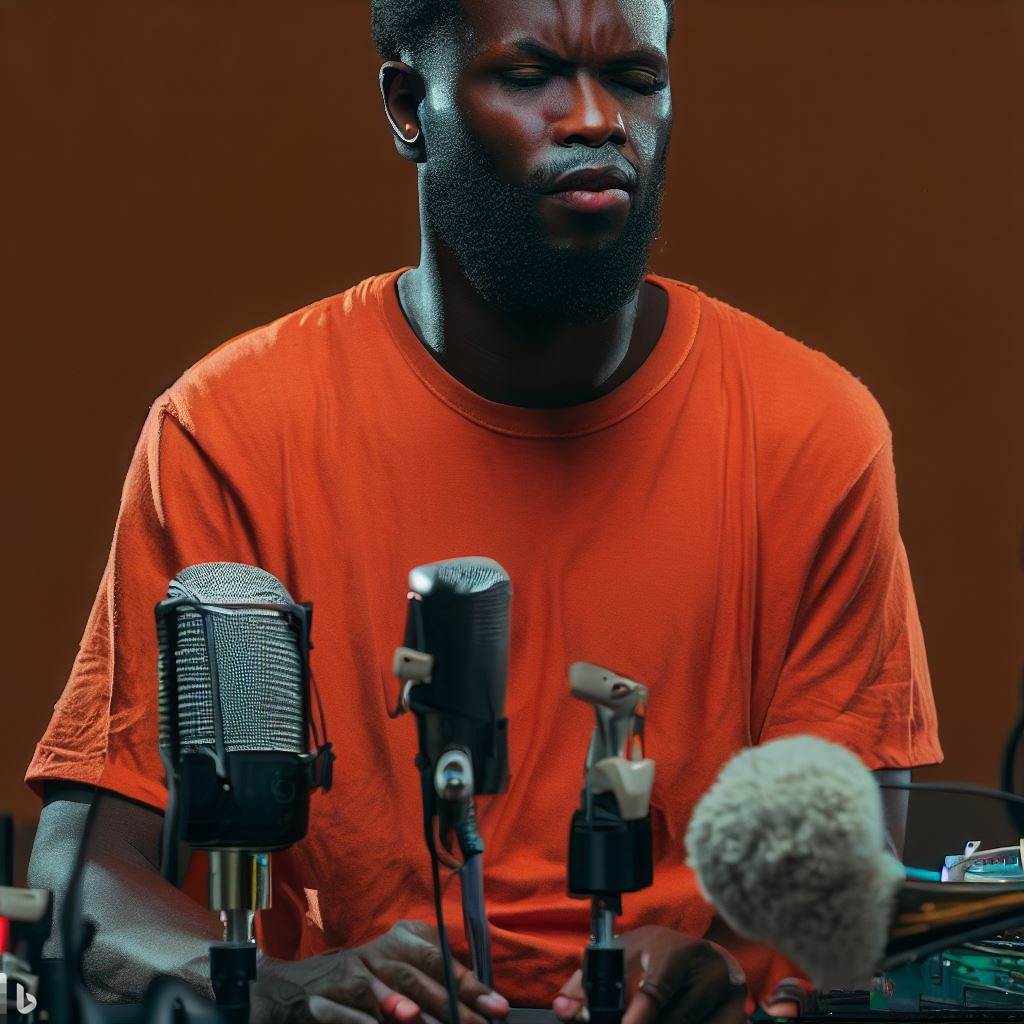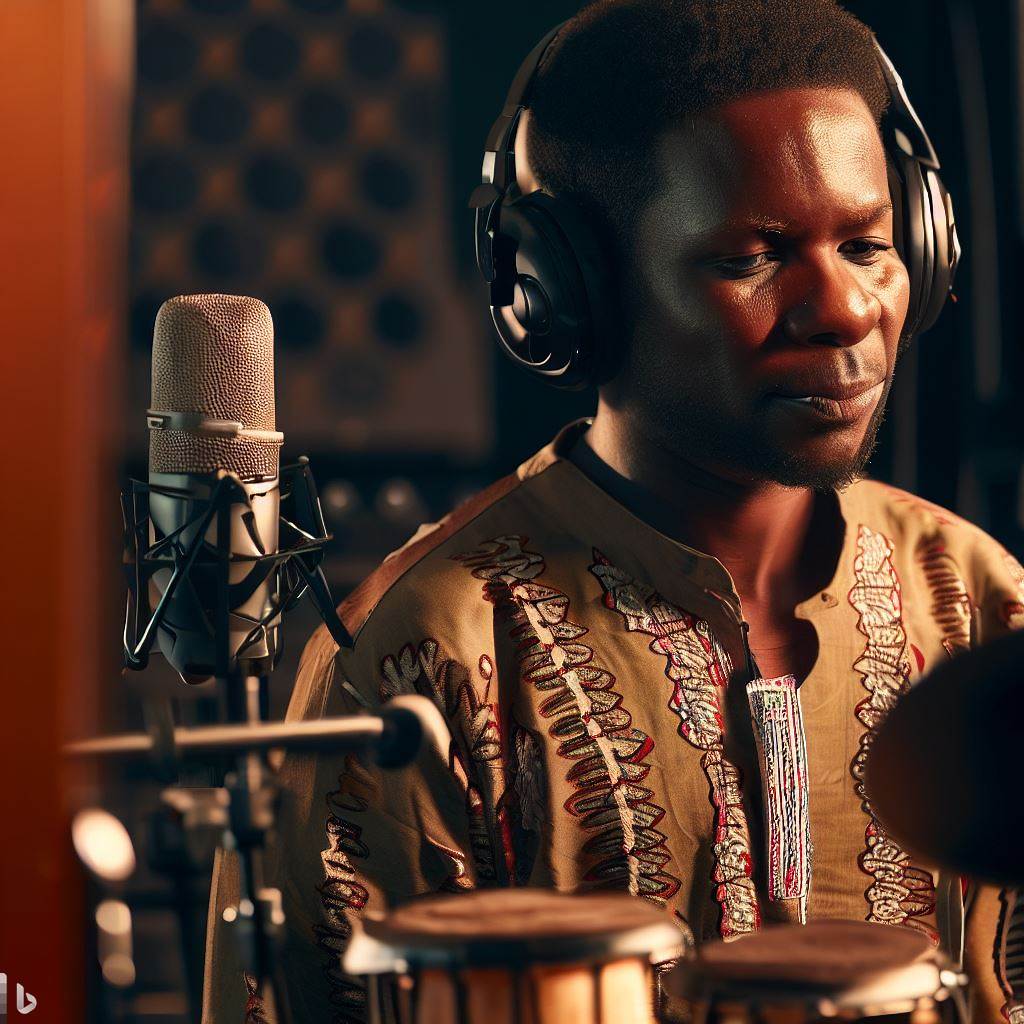Introduction
In the world of film production, Foley artists play a crucial role in enhancing the audio experience.
They create and record sound effects to match the actions on screen, making the viewer’s immersion more realistic.
Foley art is vital as it adds depth and emotion to a film, allowing the audience to feel more connected to the story.
In the Nigerian perspective, Foley art has gained recognition and made significant contributions to the local film industry, known as Nollywood.
Nigerian Foley artists have mastered the craft, bringing a unique touch to their work.
They understand the cultural nuances and specific sounds that resonate with the Nigerian audience, ensuring a more authentic and relatable film experience.
Nigerian Foley artists go beyond traditional techniques and utilize everyday objects found locally to create their sound effects.
They use items such as dried leaves, wooden sticks, and sand to replicate natural sounds, perfectly capturing the essence of Nigerian surroundings in their films.
This approach not only showcases their creativity but also helps in keeping production costs low.
Furthermore, the Nigerian perspective on Foley art emphasizes the importance of storytelling.
Foley artists work closely with directors and sound designers to understand the narrative and create sound effects that enhance the emotions and impact of each scene.
They pay attention to details, adding subtleties and layers of sound to create a more immersive experience for the viewers.
In the end, the role of Foley artists in film production is essential as they bring life to on-screen actions through sound effects.
The Nigerian perspective contributes unique approaches and techniques to Foley art, adding cultural authenticity and enhancing storytelling in Nollywood films.
It is a crucial aspect of the filmmaking process that should not be underestimated.
Basic Foley Tools
In the world of film and television production, Foley artists play an essential role in creating realistic sound effects.
This is true in Nigeria as well, where Foley artists need to have the right tools to achieve their desired results.
In this section, we will explore some basic Foley tools that are crucial for a Nigerian Foley artist.
Foley pits and surfaces
One of the most important tools for a Foley artist is the Foley pit and surfaces.
The pit provides a space for the artist to perform and record various sounds, while the surfaces are used to create different textures and tones.
These surfaces can be anything from cement or wood to gravel or sand. Having a well-equipped Foley pit and a variety of surfaces allows Nigerian Foley artists to recreate a wide range of sounds accurately.
Footsteps Foley props
Another essential tool for a Foley artist is a collection of footsteps Foley props. These props are used to mimic different types of footsteps, such as walking, running, or even tiptoeing.
Some common footsteps Foley props include shoes with different soles, jingle bells, or even sponges to create the sound of footsteps on different surfaces.
A Nigerian Foley artist needs to have a diverse collection of these props to be able to accurately recreate footsteps in various scenes.
Foley microphones and recording equipment
Foley microphones and recording equipment are also crucial tools for a Nigerian Foley artist. These specialized microphones are designed to capture every detail of the sound being created.
A high-quality microphone can make a significant difference in the final sound effect.
Additionally, recording equipment, such as a multi-track recorder or a digital audio workstation, allows the artist to capture and manipulate the sound in post-production.
In addition to these basic Foley tools, a Nigerian Foley artist may also utilize other equipment based on the specific project’s requirements.
For example, if the scene involves a lot of weapon sounds, the artist may need additional tools such as replicas of guns or swords.
On the other hand, if the scene requires unique sounds like animal noises or vehicle engines, the artist may require specific props or equipment related to those sounds.
To summarize, a Nigerian Foley artist relies on several essential tools to create realistic sound effects.
These tools include Foley pits and surfaces, footsteps Foley props, and Foley microphones and recording equipment.
With these tools at their disposal, Nigerian Foley artists can captivate audiences with their skillful sound designs.
It is crucial for Nigerian filmmakers and production houses to invest in these tools and provide Foley artists with the necessary resources to create outstanding sound effects that enhance the overall viewing experience.
Read: Salaries and Career Progression for Foley Artists in Nigeria
Specialized Foley Tools
In this blog section, we will be focusing on the specialized tools that are essential for a Foley artist in Nigeria.
These tools are crucial for creating realistic and immersive sound effects for films, television shows, and other forms of media.
Foley artists use a variety of props to mimic different sounds and actions, and having the right tools is essential to their craft.
Foley props for handling clothing movements
One important category of specialized Foley tools is props for handling clothing movements.
These props help create realistic sounds for a character’s clothing as they move and interact with their environment.
Some examples of these props include gloves, coats, scarves, and other fabrics.
Foley artists use these props to create sounds such as rustling, flapping, and swishing, which help bring characters and scenes to life.
Foley props for handling specific props (e.g., weapons, tools)
Another category of specialized Foley tools is props for handling specific objects or props. These tools are used to recreate sounds for actions such as handling weapons, tools, or other items.
For example, a Foley artist might use specific props to create the sound of a sword being unsheathed, a gun being cocked, or a hammer hitting a nail.
These props are often made from materials that mimic the weight and texture of the real objects, allowing the Foley artist to create convincing sound effects.
Foley props for environmental sounds (e.g., rain, wind)
In addition to props for handling clothing and specific objects, Foley artists also use props for creating environmental sounds.
These props help recreate sounds that occur in nature or specific settings. For example, a Foley artist might use props to create the sound of rain, wind, or footsteps on different surfaces.
These props can include items such as plastic sheets for rain, wind machines for wind effects, or different types of flooring for footsteps.
By using these props, Foley artists can enhance the overall atmosphere and realism of a scene.
Having access to these specialized Foley tools is crucial for Nigerian Foley artists. However, it is important to note that not all of these tools may be readily available in Nigeria.
Foley artists in Nigeria often face challenges in sourcing or even creating their own specialized props.
This requires creativity and resourcefulness, as they may need to find alternative materials or adapt existing tools to suit their needs.
Despite these challenges, Nigerian Foley artists continue to push the boundaries of their craft and find innovative ways to create realistic sound effects.
Their dedication and passion for their work drive them to overcome obstacles and deliver exceptional sound design.
As the Nigerian film industry continues to grow, so too does the demand for skilled Foley artists who can create immersive soundscapes.
In fact, specialized Foley tools play a vital role in the work of Nigerian Foley artists.
These tools, including props for handling clothing movements, specific objects, and environmental sounds, enable Foley artists to create realistic and engaging sound effects.
While there may be challenges of availability, Nigerian Foley artists continue to demonstrate resourcefulness and creativity in their pursuit of excellence in sound design.
Read: Unique Soundscapes: The Role of Foley Artists in Nollywood
Creative Foley Tools
When it comes to creating sound effects for films, Foley artists need to think outside the box.
While there are traditional tools used in the industry, there are also unconventional objects that can be used to create unique sounds.
In Nigeria, where creativity is abundant, Foley artists have discovered innovative ways to enhance their art.
Here are some creative Foley tools commonly used by Nigerian artists:
Unconventional objects used for creating unique sounds
- Squeaky shoes: By modifying their footwear, Foley artists can create the sound of footsteps on different surfaces.
- Vegetable bags: The rustling sound of vegetable bags can be used to mimic the sound of leaves or grass in a natural environment.
- Coconut shells: Foley artists use coconut shells to recreate the sound of horse hooves or other animal movements.
- Empty soda cans: These cans can be crushed to create the sound of footsteps on gravel or the popping of a fire.
Foley props for magical or fantasy elements in films
- Wind chimes: These delicate instruments can be used to add a mystical element to a scene or represent the sound of magic.
- Tibetan singing bowls: The resonating sound produced by these bowls can create an ethereal atmosphere or symbolize a supernatural force.
- Rainsticks: When turned upside down, these instruments produce the soothing sound of rainfall, perfect for fantasy or dream sequences.
- Musical instruments (e.g., harps, flutes, bells): Foley artists can play them in a specific way to produce mystical sounds associated with otherworldly beings or events.
Traditional Nigerian instruments for Foley art
- Talking drum (Gangan): This drum, often used in Nigerian music, can create a wide range of sounds. Foley artists use it to mimic the sound of distant drums or tribal gatherings.
- Omele (thumb piano): By plucking the metal tongues of this instrument, Foley artists can create magical or tinkling sounds for fantasy or dream sequences.
- Ogene: This traditional gong is commonly used in Nigerian ceremonies. Foley artists can use it to produce powerful and resonant sounds, such as thunder or explosive effects.
- Udu: This clay drum can be played by striking or hitting its surface to produce deep and resonating bass sounds, suitable for creating heavy impacts or rumbling atmospheres.
In a nutshell, Foley artists in Nigeria have embraced creativity and have learned to use unconventional objects to enhance their art.
By thinking outside the box and exploring traditional Nigerian instruments, they bring unique and authentic sounds to their work.
These creative Foley tools not only make their work more interesting but also showcase the rich culture and traditions of Nigeria in the film industry.
Read: Becoming a Foley Artist in Nigeria: The Complete Guide

Digital Foley Tools
Foley artists are essential in the film industry, as they add realistic sound effects to on-screen actions.
In today’s digital age, the use of technology has revolutionized the art of Foley.
Let’s explore the world of digital Foley tools and their advantages and challenges.
Overview of Foley Software and Plugins
- Pro Tools: This industry-standard software allows Foley artists to record, edit, and mix sounds with precision.
- Soundminer: A powerful sound database and search engine that helps Foley artists find and organize various sound effects.
- Native Instruments Kontakt: A popular sampler plugin that enables Foley artists to create unique sounds by manipulating recorded samples.
Advantages of Digital Foley
- Unlimited Sound Options: Digital tools offer a vast library of sounds, giving Foley artists endless possibilities to create and experiment.
- Time Efficiency: With digital tools, Foley artists can quickly access and manipulate sounds, reducing the time required to achieve desired effects.
- Consistency: Digital Foley allows artists to maintain consistency throughout a project by using the same set of sounds repeatedly.
- Flexibility: Foley artists can modify and fine-tune sounds easily, adapting them to fit specific scenes or creating entirely new effects.
Challenges of Digital Foley
- Authenticity: While digital tools offer convenience, achieving the same level of authenticity as physical props can be challenging.
- Missing Real-Time Feedback: Physical props provide immediate feedback to Foley artists, allowing them to adjust sounds accordingly. Digital tools may lack this interactive element.
- Technical Skills: Foley artists need to develop proficiency in using various software and plugins to maximize the potential of digital tools.
Incorporating Digital Tools alongside Physical Foley Props
- Hybrid Approach: Foley artists can combine digital tools with traditional physical props to achieve a seamless blend of realistic sounds.
- Recording Foley Props: Artists can capture the sounds of their physical props using professional microphones and later manipulate them digitally.
- Layering Sounds: Foley artists can add digital sound layers to enhance and enrich physical prop sounds, creating a more immersive experience.
- Experimentation: Digital tools provide an opportunity for Foley artists to explore new sounds and techniques that may not be possible with physical props alone.
In review, digital Foley tools offer numerous advantages, including unlimited sound options, time efficiency, consistency, and flexibility.
However, challenges regarding authenticity, missing real-time feedback, and the need for technical skills persist.
By incorporating digital tools alongside physical Foley props, artists can achieve a perfect balance of realism and creativity in their sound effects.
Read: Challenges and Triumphs of Nigerian Animation Directors
Foley Techniques
When it comes to Foley techniques, there are several essential aspects that Nigerian Foley artists emphasize.
Synchronization and timing, proper microphone placement, and experimenting with different Foley approaches and textures are all crucial elements in this craft.
Importance of Synchronization and Timing
Synchronization and timing are vital factors that contribute to the overall effectiveness of Foley work.
Foley artists in Nigeria understand that synchronization ensures that every sound matches the action on screen.
By meticulously timing their sound effects, they bring a sense of realism and immersion to the audience’s experience.
Foley artists in Nigeria understand the crucial role synchronization and timing play in creating realistic sound effects. Every action on screen must match the sound produced.
Proper Microphone Placement for Sound Quality
The placement of microphones is another critical consideration for Nigerian Foley artists. They know that capturing high-quality sound requires careful placement of microphones.
By strategically positioning the microphones, they can accurately capture the desired sound without any unwanted background noise or distortion.
Achieving high-quality sound requires Foley artists to place their microphones strategically. Positioning the microphone correctly ensures that the desired sound is captured accurately.
Experimenting with Different Foley Approaches and Textures
In Nigeria, Foley artists have mastered the art of experimentation. They creatively explore various approaches and textures to enhance the sound effects and bring authenticity to the scenes.
Moreover, Nigerian Foley artists are known for their willingness to experiment with different approaches and textures.
They understand that no two scenes are alike, and each requires a unique treatment.
By exploring various techniques and textures, they can create sound effects that perfectly complement the visuals and enhance the storytelling.
Publish Your Professional Profile, Business or Brand
Showcase your expertise, gain trust, and boost visibility instantly on Professions.ng.
Publish NowFor example, a Foley artist might experiment with different materials to create the sound of footsteps on different surfaces.
They might use coconut shells for footsteps on a beach, or dried leaves for footsteps in a forest.
This attention to detail and willingness to experiment is what sets Nigerian Foley artists apart.
Additionally, Foley artists in Nigeria are well-versed in the use of props and Foley pits. They understand the importance of having a variety of props and Foley pits to produce a wide range of sounds.
From footsteps to door creaks, they rely on their extensive collection of props to recreate realistic sound effects.
In general, Foley techniques are an essential part of a Foley artist’s toolkit in Nigeria.
Synchronization and timing, proper microphone placement, and the willingness to experiment with different approaches and textures are all crucial aspects that contribute to the success of Foley work.
Nigerian Foley artists continue to push boundaries and bring their unique perspectives to this craft, enhancing the cinematic experiences for audiences.
Challenges and Solutions
In a country like Nigeria, Foley artists face unique challenges in their craft. Budget constraints often hinder their access to specialized Foley tools, making it necessary to find affordable alternatives.
Fortunately, creative improvisation can save the day when specific tools are lacking.
Dealing with budget constraints for Foley tools in Nigeria
Dealing with budget constraints requires resourcefulness and a willingness to explore local markets for materials that can be repurposed into Foley tools.
Building a network of fellow Foley artists is also valuable, as they can share resources and reduce costs together.
Seeking sponsorships or grants from organizations supporting the arts in Nigeria can provide the financial assistance needed to invest in essential tools gradually.
Creative improvisation when lacking specific tools
When specific tools are not readily available, Foley artists in Nigeria have learned to rely on their creativity and adaptability.
Use everyday objects as tool substitutes. Experiment with materials for desired sound effects in surroundings.
Modifying existing tools to serve multiple purposes and expanding their functionality is also a common practice.
Foley artists look up to experienced professionals for inspiration and learn from their improvisation techniques.
Collaborating with sound designers and engineers for optimal results
Collaboration with sound designers and engineers is essential for Foley artists to achieve optimal results.
Open communication channels must be established to understand the requirements of the sound team.
By collaborating from the early stages of pre-production, Foley artists can ensure a seamless integration of Foley elements into the final sound design.
Seeking feedback and guidance from sound professionals allows them to enhance the impact of their work.
Attending workshops and seminars on sound design provides valuable insights and improves collaboration skills.
Foley artists in Nigeria must also be adaptable and flexible to accommodate changes suggested by the sound team.
Their willingness to embrace feedback and make adjustments demonstrates their dedication to achieving the best possible results.
In essence, challenges faced by Foley artists in Nigeria include budget constraints, a lack of specific tools, and the need for collaboration with sound designers and engineers.
Overcoming these challenges requires resourcefulness, creativity, and adaptability.
By exploring affordable alternatives, improvising with available resources, and fostering strong collaborations, Nigerian Foley artists can continue to produce high-quality sound effects for film and other audiovisual projects.
Delve into the Subject: How to Get Your Work Published in Nigeria
You Might Also Like: Software Tools Every Nigerian Animation Director Needs
Notable Nigerian Foley Artists
Highlighting prominent Foley artists from Nigeria
- Kunle Afolayan – A renowned filmmaker and Foley artist, known for his attention to detail in sound design.
- Tunde Kelani – An experienced Foley artist who has created immersive soundscapes for numerous Nollywood films.
- Funke Akindele-Bello – A multi-talented artist who has dabbled in acting, directing, and Foley artistry.
Their contributions and impact on Nigerian cinema
- These Foley artists have played a crucial role in enhancing the overall cinematic experience in Nigeria.
- Their attention to detail and ability to create realistic and immersive sound effects has taken Nigerian films to a new level.
- Through their work, they have contributed to the growth and recognition of Nollywood, the Nigerian film industry.
Showcasing their unique techniques and preferred tools
- Kunle Afolayan employs a combination of organic and digital Foley techniques to achieve realistic soundscapes.
- Tunde Kelani often uses unconventional objects to create unique sounds, adding a distinct flavor to his work.
- Funke Akindele-Bello combines her acting skills with Foley artistry, allowing her to fully immerse herself in the sound creation process.
Nigeria is home to talented Foley artists who have made significant contributions to the Nigerian film industry.
Their unique techniques and preferred tools have shaped the way sound is perceived in Nigerian cinema.
By highlighting their work, we can appreciate the importance of Foley artistry and the impact it has on creating immersive film experiences.
Conclusion
This post has highlighted the essential Foley tools for Nigerian artists. These tools include a variety of everyday objects like shoes, kitchen utensils, and household items.
It is important for aspiring Foley artists in Nigeria to be creative and resourceful, using the tools they have access to.
Furthermore, this section has emphasized the importance of combining traditional tools with modern techniques.
Foley artists should not limit themselves to only using physical objects but should also explore the possibilities offered by digital sound libraries and software.
To recap, the essential Foley tools for Nigerian artists include a variety of objects like shoes, kitchen utensils, and household items.
Foley artists should also consider using digital sound libraries and software to enhance their work. Lastly, this post aims to encourage aspiring Foley artists in Nigeria to pursue their passion.
Despite challenges, Nigerian artists have the potential to make a mark in the industry by using their unique perspective and incorporating their culture into their work.
Nigerian Foley artists fuse classic tools and modern methods for genuine sound effects, infusing Nigerian films with captivating dimensions.




